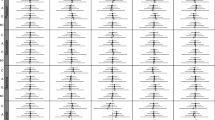Abstract
A brief introduction to the mathematical theory involved in model fitting is provided. The properties of maximum-likelihood estimates are described, and their advantages in fitting structural models are given. Identification of models is considered. Standard errors of parameter estimates are compared with the use of likelihood-ratio (L-R) statistics. For structural modeling, L-R tests are invariant to parameter transformation and give robust tests of significance. Some guidelines for fitting models to data collected from twins are given, with discussion of the relative merits of parsimony and data description.
Similar content being viewed by others
Rererences
Akaike, H. (1970). Statistical predictor identification.Ann. Inst. Stat. Math. 21:243–247.
Akaike H. (1987). Factor analysis and AIC.Psychometrika 52:317–332.
Bentler, P. M. (1984).Theory and Implementation of EQS: A Structural Equations Program, BMD Statistical Software, Los Angeles.
Boomsma, D. I., van den Bree, M. B. M. Orlebeke, J. F., and Molenaar, P. C. M. (1989). Resemblance of parents and twins in sports participation and heart rate.Behav. Genet. 19:123–141.
Browne, M. W. (1984). Asymptotically distribution-free methods for the analysis of covariance structures.Br. J. Math. Stat. Psychol. 37:62–83.
Cavalli-Svorza, L. L., and Bodmer, W. F. (1971).The Genetics of Human Populations, W. H. Freeman, San Francisco.
Dolan, C. V., Molenaar, P. C. M., and Boomsma, D. I. (1989). LISREL analysis of twin data with structured means.Behav. Genet. 19:51–62.
Edwards, A. W. F. (1972).Likelihood, Cambridge University Press, London.
Fisher, R. A. (1920). A mathematical examination of the methods of determining the accuracy of an observation by the mean error, and by the mean square errorMonth. Notices Roy. Astron. Soc. 80:758–770.
Fisher, R. A. (1922). On the mathematical foundations of theoretical statistics,Philos. Trans. Roy. Soc. Lond. A 222:309–368.
Heath, A. C., Neale, M. C., Hewitt, J. K., Eaves, L. J., and Fulker, D. W. (1989). Testing structural equation models for twin data using LISREL.Behav. Genet. 19:9–35.
Jöreskog, K. G., and Sörbom, D. (1986)LISREL: Analysis of Linear Structural Relationships by the Method of Maximum Likelihood, National Educational Resources, Chicago.
Kendall, M., and Stuart A. (1977).The Advanced Theory of Statistics, Vol. 1, Macmillan, New York.
Marsh, H. W., Balla, J. R., and McDonald, R. P. (1988). Goodness of fit indexes in confirmatory factor analysis: The effect of sample size.Psychol. Bull. 103:391–410.
Mardia, K. V., Kent, J. K., and Bibby, J. M. (1979).Multivariate Analysis, Academic Press, New York.
Martin, N. G., and Boomsma, D. I. (1989). Willingness to drive when drunk and personality: A twin study.Behav. Genet. 19:97–111.
Martin, N. G., Eaves, L. J., and Fulker, D. W. (1979). The genetical relationship of impulsiveness and sensation seeking to Eysenck's personality dimensions.Acta Genet. Med. Gemellol. 28:197–210.
McArdle, J. J. (1986). Latent variable growth within behavior genetic models.Behav. Genet. 16:163–200.
Muthén, B. (1988).LISCOMP: A Program for Advanced Research, Scientific Software, Mooresville, Ind.
Neale, M. C., and Martin, N. G. (1989). The effects of age, sex, and genotype on self-report drunkenness following a challenge dose of alcohol.Behav. Genet. 19:63–78.
Phillips, K., Fulker, D. W., and Rose, R. J. (1987). Path analysis of seven fear factors in adult twin and sibling pairs and their parents.Genet. Epidemiol. 4:345–355.
Tucker, L. R., and Lewis, C. (1973). A reliability coefficient for maximum likelihood factor analysis.Psychometrika 38:1–10.
Vlietinck, R., Derom, R., Neale, M. C., Maes, H., van Loon, H., van Maele, G., Derom, C., and Thiery, M. (1989). Genetic and environmental variation in the birth weight of twins.Behav. Genet. 19:151–161.
Author information
Authors and Affiliations
Additional information
The theoretical work and data analysis described in this paper were made possible by NATO Grant 86/0823 and grants from the Belgian National Research Fund, the State University of Gent, and the Catholic University of Leuven. We are also grateful to Drs. R. Vlietinck and R. Derom for excellent organization of the successful workshop. A.C.H., M.C.N., J.K.H., and L.J.E. were supported by NIH Grants MH-40828, AA-06781, GM-30250, AG-04954, and HL-31010. D.W.F. was supported by NIH Grants HD-19802 and HD-18426.
Rights and permissions
About this article
Cite this article
Neale, M.C., Heath, A.C., Hewitt, J.K. et al. Fitting genetic models with LISREL: Hypothesis testing. Behav Genet 19, 37–49 (1989). https://doi.org/10.1007/BF01065882
Issue Date:
DOI: https://doi.org/10.1007/BF01065882



